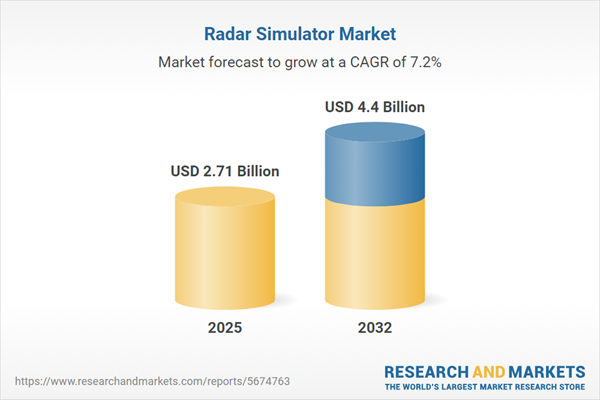Speak directly to the analyst to clarify any post sales queries you may have.
The radar simulator market is evolving rapidly, shaped by advancing technologies, shifting defense and civilian requirements, and the need for validated, cost-efficient testing and training environments. As organizations seek greater operational readiness while minimizing live testing risks and costs, radar simulation platforms are becoming indispensable across major industry verticals.
Market Snapshot: Radar Simulator Market Growth and Outlook
The radar simulator market grew from USD 2.53 billion in 2024 to USD 2.71 billion in 2025. It is expected to continue growing at a CAGR of 7.15%, reaching USD 4.40 billion by 2032. This expansion is driven by increasing investments in defense modernization, greater adoption of digital radar simulation technologies in automotive and maritime sectors, and heightened regulatory focus on safe, repeatable test environments. Advanced simulation capabilities respond directly to the demand for efficient scenario customization and fast validation cycles.
Scope & Segmentation: Radar Simulator Market Coverage
- Applications: Aerospace and defense (military training, weapon system testing), automotive testing (advanced driver assistance systems, autonomous driving, collision avoidance), maritime, public safety.
- Product Types: Analog radar simulators and digital radar simulators.
- Frequency Bands: C-Band (lower C-Band, upper C-Band), Ka-Band, S-Band, X-Band.
- Deployment Modes: Fixed installations (field, laboratory) and portable units (bench portable, field portable).
- Operation Modes: Hardware in the loop (sensor in the loop, signal in the loop), software in the loop (algorithm simulation, digital twin simulation), real time simulation, post processing.
- Geographic Segmentation: Americas (United States, Canada, Mexico, Brazil, Argentina, Chile, Colombia, Peru), Europe, Middle East, Africa (United Kingdom, Germany, France, Russia, Italy, Spain, Netherlands, Sweden, Poland, Switzerland, United Arab Emirates, Saudi Arabia, Qatar, Turkey, Israel, South Africa, Nigeria, Egypt, Kenya), Asia-Pacific (China, India, Japan, Australia, South Korea, Indonesia, Thailand, Malaysia, Singapore, Taiwan).
- Notable Companies: Thales S.A., Raytheon Technologies Corporation, Lockheed Martin Corporation, CAE Inc., L3Harris Technologies, Inc., BAE Systems plc, Leonardo S.p.A., Northrop Grumman Corporation, Saab AB, Elbit Systems Ltd.
Key Takeaways: Actionable Insights for Senior Decision-Makers
- Transitioning from analog to modular digital radar simulation enables rapid scenario adaptation, risk reduction, and improved compliance with evolving industry standards.
- Integrated artificial intelligence and machine learning are redefining simulation precision, supporting predictive analytics, adaptive waveform generation, and continuous digital twin validation across scenarios.
- Defense-driven requirements emphasize joint force readiness and simulation of cross-domain operations, while civilian use is expanding in automotive autonomous driving validation and public safety communications.
- Demand for hybrid deployment models, including bench portable and field portable simulators, is rising as organizations seek on-demand calibration and off-site validation capabilities.
- Flexible commercial models, such as subscription-based and outcome-focused offerings, are becoming common, enabling broader access and lower up-front costs for advanced radar simulation services.
Tariff Impact: Navigating Trade and Supply Chain Disruptions
United States tariffs have added complexity to global procurement and supply networks within the radar simulation ecosystem. Organizations are meeting these challenges by diversifying suppliers, investing in nearshoring, and strengthening domestic manufacturing. Tariff pressures are also driving the formation of industry consortia for streamlined certification and collaborative resource sharing.
Methodology & Data Sources
The research draws on primary consultations with over thirty experts spanning defense technology, automotive systems, and public safety. Secondary validation includes technical papers, standards publications, vendor documentation, and independent test reports. Advanced analytics underpin scenario-based evaluation and trend identification, ensuring transparency and reliability.
Why This Report Matters
- Provides senior leaders with granular segmentation and actionable insights across applications, frequency bands, and deployment models to support strategic procurement, investment, and partnership decisions.
- Offers a global perspective on evolving regulatory and operational demands, reinforcing the criticality of innovation and agility amid complex supply chain dynamics.
- Enables informed evaluation of technology trends impacting both defense and civilian radar simulation markets with rigorous, up-to-date methodology.
Conclusion
Strategic adoption of radar simulation platforms is essential for modern operational readiness and competitive positioning. Industry leaders leveraging digital transformation, adaptive deployment, and collaborative partnerships will be best prepared to meet sector demands and future challenges.
Additional Product Information:
- Purchase of this report includes 1 year online access with quarterly updates.
- This report can be updated on request. Please contact our Customer Experience team using the Ask a Question widget on our website.
Table of Contents
3. Executive Summary
4. Market Overview
7. Cumulative Impact of Artificial Intelligence 2025
List of Figures
Samples

LOADING...
Companies Mentioned
The key companies profiled in this Radar Simulator market report include:- Thales S.A.
- Raytheon Technologies Corporation
- Lockheed Martin Corporation
- CAE Inc.
- L3Harris Technologies, Inc.
- BAE Systems plc
- Leonardo S.p.A.
- Northrop Grumman Corporation
- Saab AB
- Elbit Systems Ltd.
Table Information
| Report Attribute | Details |
|---|---|
| No. of Pages | 182 |
| Published | October 2025 |
| Forecast Period | 2025 - 2032 |
| Estimated Market Value ( USD | $ 2.71 Billion |
| Forecasted Market Value ( USD | $ 4.4 Billion |
| Compound Annual Growth Rate | 7.1% |
| Regions Covered | Global |
| No. of Companies Mentioned | 11 |









